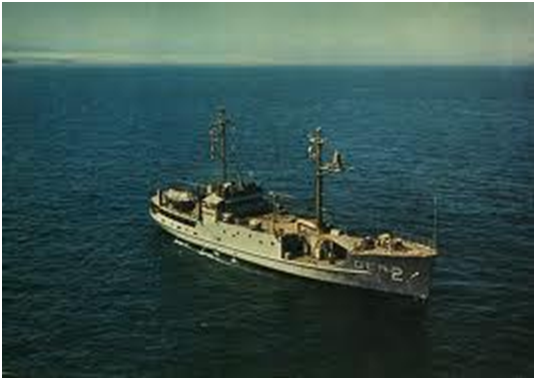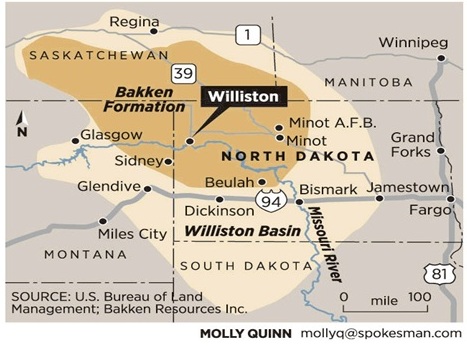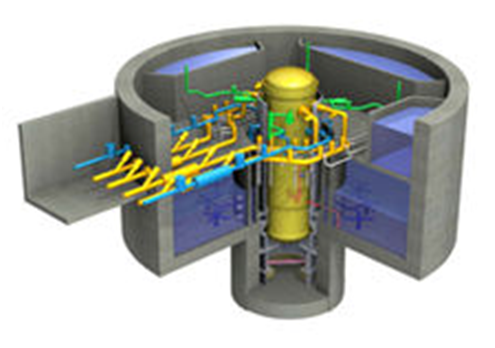
Blog
-
Geiger Readings for January 29, 2013
Ambient office = 135 nanosieverts per hourAmbient outside = 107 nanosieverts per hourSoil exposed to rain water = 101 nanosieverts per hourBaby Gold Potato from Top Foods = 65 nanosieverts per hourTap water = 92 nanosieverts per hourFiltered water = 87 nanosieverts per hour -
Nuclear Weapons 63 – 1968 U.S. Plan to Nuke North Korea
The only nuclear bombs have been used during wartime were the two that were dropped on Hiroshima and Nagasaki by the United States in World War II. However, there have been plans by the U.S. and other countries to use nuclear weapons that were not carried out. Few of these plans were widely publicized and are not known by the public because they were classified military secrets. Every now and then, a particular plan surfaces. This blog post is about one such plan.
In 1968, the USS Pueblo was captured by North Korean. It was a sophisticated electronic surveillance ship being used to intercept electronic communications from North Korea. The US maintains that the Pueblo was in international waters when it was captured but the North Koreans claim that it was in their territorial waters. The crew was held and tortured for over a year. The ship carried a huge amount of U.S. intelligence including devices used to decipher encrypted U.S. military communications.
During this period, the U.S. was concerned that the U.S.S.R and/or China might be involved and have access to sensitive U.S. intelligence and the decoders. There was also concern that North Korea was planning on invading South Korea. Spies and saboteurs from North Korea were very active in that period, crossing the Korean Demilitarized Zone that separate the two Koreas in order to attack targets in the south. Under pressure from the Soviets, North Korea eventually released the crew of the ship which defused the crisis. They did keep the Pueblo.
Some U.S. documents were recently declassified that are related to the Pueblo incident. They concern contingency plans that were drawn up to deal with the capture of the Pueblo and the possibility of a North Korean invasion of South Korea. At the time of the Pueblo capture, the U.S. military called for sending Navy ships to North Korea to intimidate the North Koreans. Unfortunately for that suggested response, the Navy was occupied with the war in Viet Nam and no ships were sent on that mission. So the U.S. military suggested that we invade North Korea. They said that we could use our B-52 high altitude bombers to obliterate the North Korean air force. One problem with these invasion plans is that they would require that the U.S. pull out of Viet Nam completely to free up the twelve divisions of troops and the forty tactical bomber squadrons required. The five different invasion plans were collectively known as “Fresh Storm.”
In addition to the invasion plans, there was a plan to use nuclear weapons. This plan was called “Freedom Drop.” The commander of the U.S. Pacific Fleet had drawn up the plans for the nuclear attack against North Korean military targets. The Chairman of the U.S. Joint Chiefs of Staff approved the plan but there was a delay in relaying that approval to the Pacific Fleet. The plan called for using Honest John rockets and Sergeant missiles to deliver seventy kiloton warhead to North Korean targets. If that plan had been carried out, it would have devastated North Korea, killing millions of people. South Korea would have fallen victim to fallout and other environmental destruction that would have taken many lives. Fortunately for all the people living on the Korean peninsula, the plan was never carried out. The U.S. military is concerned with using weapons to attack enemies. In the U.S., the civilian government controls the military which reduces the possibility of U.S. military action and encourages other approaches to international tension including diplomacy and trade.
U.S.S. Pueblo:
-
Radiation News Roundup January 28, 2013
TEPCO says Fukushima spent fuel removal task is even worse than anticipated. enenews.com
Construction on Vietnam’s first nuclear power plant at Phuoc Dinh in the southern Ninh Thuan province will not commence later this year as previously planned. world-nuclear-news.org
Washington has been pressing Tokyo to return over 300 kg of mostly weapons-grade plutonium given to Japan for research purposes during the Cold War era. japantimes.co.jp
-
Geiger Readings for January 28, 2013
Ambient office = 85 nanosieverts per hourAmbient outside = 81 nanosieverts per hourSoil exposed to rain water = 72 nanosieverts per hourBaby Gold Potato from Top Foods = 132 nanosieverts per hourTap water = 106 nanosieverts per hourFiltered water = 99 nanosieverts per hour -
Radioactive Waste 50 – North Dakota Fracking Sludge
When we talk about nuclear waste, it is almost always with respect to uranium mining, uranium fuel production, spent nuclear fuel and nuclear laboratories. I have written in the past about the ubiquity of uranium in rocks and soil all over the world. Uranium is forty times more common than silver. It combines with many different minerals in many different forms. We experience “normal background radiation” from the uranium in the ground which varies from place to place. There are other sources of nuclear waste or at least, waste materials that have radioactive constituents. Among these are the waste products from coal fired power plants and the waste products brought to the surface from fracking operations.
Fracking is a process where water, sand and various combinations of chemicals are force into a deep well under high pressure. The rock is fractured and the sand and chemicals help to keep the fractures open while oil and natural gas are released. Fracking has spread across the United States to the point where the U.S. is one of the major producers of natural gas in the world. This bounty of natural gas has lowered the price of energy to the point where some nuclear reactors have been unable to compete with natural gas for the production of electricity. On the down side, fracking is polluting the ground water and the wells in many areas with toxic chemicals and also causing earthquakes in areas that were previously quiet. And, the sludge that is pumped back to the surface from a fracking operation contains radioactive materials.
Under North Dakota ND, lies part of the Bakken Oil Shale Formation. North Dakota is home to massive fracking operation to release oil and natural gas from the Bakken Formation and is number two in U.S. oil production. In North Dakota there have been about three hundred oil spills in the last two years from fracking wells. Oil is oozing up out of the ground around the fracking operations. It is mixed with corrosive chemicals and something called technologically enhanced normally occurring radioactive material or TENORM. TENORM is produced when normally occurring radioactive material is brought to the surface by a fracking operation. From a legal standpoint, TENORM is supposed to be disposed of at a regulated TENORM waste site such as the one in Colorado. However, in order to reduce costs and time, producers in ND have been dumping TENORM in the closest and most convenient place they can find. (It was reported recently that fracking sludge containing TENORM was spread on roads in Pennsylvania during and after snow storms with a level of radioactivity that was not legal.)
In North Dakota, the fracking producers are not legally required to report oil spills at their operations and in their pipelines. The TENORM that is leaking out of their wells is mixing with ground water and soil and spreading beyond their production areas. It is a threat to human health and the whole environment. It is absolutely critical to the health and well being of the citizens of North Dakota that the laws are changed and vigorously enforced with respect to the reporting and control of oils spills from fracking sites.
-
Geiger Readings for January 27, 2013
Underground holes may be needed to search for Fukushima’s 3 molten cores. enenews.com
Highly radioactive groundwater now flowing under the Fukushima Unit 1 reactor. enenews.com
Costly fossil fuel imports have helped push Japan into a trade deficit for a third consecutive year as the country’s nuclear plants remain off line. world-nuclear-news.org
Washington state’s Department of Ecology has levied a fine against the U.S. Department of Energy, which also promised to change waste management practices at three facilities within the Hanford nuclear complex. nuclearstreet.com
-
Geiger Readings for January 26, 2013
Ambient office = 59 nanosieverts per hourAmbient outside = 106 nanosieverts per hourSoil exposed to rain water = 116 nanosieverts per hourBaby Gold Potato from Top Foods = 84 nanosieverts per hourTap water = 80 nanosieverts per hourFiltered water = 76 nanosieverts per hour -
Geiger Readings for January 25, 2013
Ambient office = 130 nanosieverts per hourAmbient outside = 94 nanosieverts per hourSoil exposed to rain water = 89 nanosieverts per hourCippolina Onion from Top Foods = 96 nanosieverts per hourTap water = 87 nanosieverts per hourFiltered water = 78 nanosieverts per hourAlaskan Copper River Salmon = 93 nanosieverts per hour -
Nuclear Reactors 99 – General Electric Hitachi Settles Claim for Fraud
General Electric Hitachi Nuclear Energy (GEH) is a global alliance between General Electric in the United States and Hitachi in Japan. The company is a global provider of nuclear reactors and nuclear industry services. GEH is working on several different designs for advanced nuclear reactors.
GEH is in the process of having the design of its “Economically Simplified Boiling Water Reactor” (ESBWR) certified by the United States Nuclear Regulatory Commission. The NRC is also reviewing applications for construction and operation of ESBWR at Dominion’s North Anna power plant and Detroit Edison’s Fermi sites.
Final approval of the design and applications has been held up by a whistleblower’s lawsuit from a former employee of GEH, under the False Claims Act, that alleges that “GEH concealed knownAZAZAZAZAZAZ flaws in the analysis of steam dryers and had made false representations that it had analyzed the components in accordance with applicable standards and verified the accuracy of its modelling.” The whistleblower is entitled to part of any money recovered by the U.S. Department of Justice from the lawsuit.
Steam dryers are used to remove excess moisture from the steam created by the nuclear reactor before it is delivered to the turbines used to generated electricity. They are “non-safety critical components.” GEH issued a statement that their steam dryers were in use in reactors around the globe and that they had always worked properly and caused no problems.
The certification of the design has been held up for two years by the lawsuit. The design of the ESBWR had been given final approval in March of 2011 after a final safety evaluation. The NRC said that it had concluded that the ESBWR design was safe and technically acceptable after a six year review process. However, the lawsuit over the steam dryers interrupted the final stages of the review process. The NRC proceeded with a study of the steam dryer modelling methodology and further analyzes and reviews. The normal certification process will be resumed after a final safety evaluation report and review of the steam dryer problems is finished.
GEH has issued a statement explaining why it agreed to a 2.7 million dollar fine to resolve the lawsuit. “Even though GEH denies the allegations, we believe that resolution of this matter supports our continuing efforts to maintain and enhance a positive working relationship with the US government, and more specifically the Nuclear Regulatory Commission”. The U.S. Department of Justice also issued a statement in which they confirmed that there were only allegations of false claims and that there had been “no determination of liability.”
It is interesting to note that Mitsubishi Heavy Industries (MHI), another nuclear contractor, is involved in a lawsuit over the closed San Onofre nuclear power plant. South California Edison (SCE), the owners of the plant allege that MHI used a faulty modelling process to OK design changes to the new turbines that SCE had ordered from them. The turbines failed in two years. MHI is counter-suing the claiming that they warned SCE that the turbine design changes could cause problems. Since it can take years for some design problems to become apparent, it is absolutely critical that modelling used in the design of nuclear reactors be good as possible.
Cutaway diagram of a GE Hitachi ESBWR:






